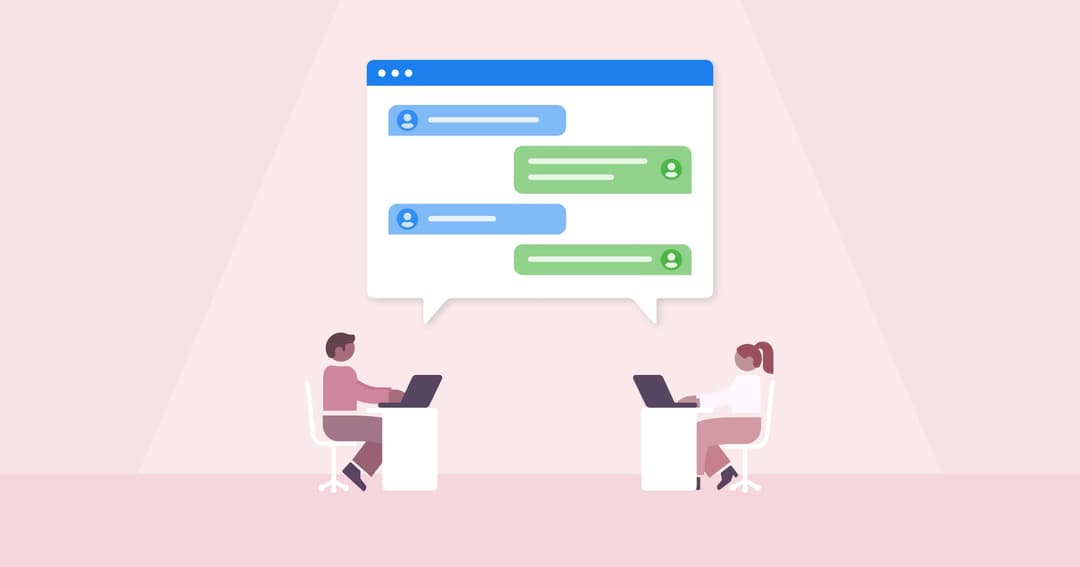Table of Contents
QUICK SUMMARY:
Improving internal agency communication can take your output and your agency's success to the next level. Learn how to improve agency communication, whether you're an office-based or fully remote team.
Improving internal agency communication can take your output and your agency's success to the next level. Learn how to improve agency communication, whether you're an office-based or fully remote team.
Effective employee communication is the backbone of a thriving marketing agency. When the leadership team aligns on improving internal communication, the impact on employee engagement can be significant, leading to a more cohesive and productive workforce.
Many agencies start with good intentions but find themselves hitting roadblocks. Misunderstandings, unclear directives, and missed deadlines frustrate even the most dedicated teams. The key to overcoming these challenges is refining how your agency communicates internally.
Imagine a workday where everyone knows their roles, priorities, and the goals they are working towards. This level of clarity not only boosts morale but also drives efficiency. The leadership team has the unique opportunity to set the tone for effective communication, ensuring that every message is clear and every team member feels heard and valued.
This guide is designed to help senior leaders navigate the complexities of internal communication. Does your team feel distant? Do projects get completed on time, or do you feel like it would be easier if everyone was on the same page?
We know that running an agency is challenging yet rewarding work.
Whether you're an in-house or remote team, your company's success and overall output depend upon effective communication with your entire team. Solid communication standards and protocols will help you fully realize your team's talents and insights. Since most of us are immersed in our computer screens and phones throughout the workday, why not use this to our advantage?
Below, we explore a few methods and marketing agency tools that will improve internal communications across your entire agency.
Benefits of Improved Internal Communication Practices
Improved internal communication practices offer numerous benefits that can transform your agency's operations. Effective leadership communication and a focus on enhancing the employee experience are critical drivers of these positive outcomes. Here are some of the significant advantages:
Increased Employee Engagement
Clear and consistent communication makes employees feel more connected to their work and the agency's mission. Regular updates, open feedback channels, and transparent decision-making processes help employees better understand their roles and contributions. This sense of clarity and involvement boosts morale and engagement, leading to higher productivity and job satisfaction.
Enhanced Collaboration and Teamwork
Effective internal communication fosters a collaborative environment where team members can easily share ideas, resources, and feedback. This level of collaboration encourages innovation and problem-solving, as employees feel comfortable contributing their perspectives. It also helps resolve conflicts quickly, ensuring that teams work harmoniously towards common goals.
Better Decision-Making
When leaders communicate effectively, they provide clear guidance and context for decisions. This clarity helps employees understand the rationale behind decisions, which in turn supports better task execution. Improved communication also ensures that relevant information is accessible to those who need it, facilitating more informed and timely decision-making processes.
Improved Leadership Communication
Strong leadership communication sets the tone for the entire agency. Leaders who communicate openly and effectively inspire trust and confidence among employees. They can clearly articulate the agency's vision, goals, and expectations, which helps align the team’s efforts and fosters a sense of purpose. Effective leadership communication also involves active listening, which makes employees feel valued and heard.
Enhanced Employee Experience
A positive employee experience is closely tied to how well an agency communicates internally. When employees feel informed, respected, and engaged, they are more likely to have a positive outlook toward their work and the organization. This positive experience can lead to lower turnover rates, higher retention of top talent, and a more positive workplace culture.
Increased Efficiency and Productivity
Clear and effective communication eliminates confusion and reduces time clarifying tasks and expectations. Employees can focus on their work without unnecessary interruptions or misunderstandings. This streamlined flow of information enhances overall efficiency and productivity, as teams can work more cohesively and complete projects on time.
Stronger Agency Culture
A well-communicated vision and values help build a strong agency culture. Everyone on the same page regarding the agency's goals and values creates a sense of unity and shared purpose. This strong culture attracts new talent and retains existing employees who are aligned with the agency's mission and values.
Agencies can create a more engaged, efficient, and cohesive workforce by prioritizing internal communication. The benefits extend beyond individual performance, impacting the agency's overall success and growth.
Internal Communication Best Practices
It's not uncommon for internal communication to be glossed over. We usually take it for granted. But by investing a little extra time into internal communication standards and procedures, you'll see overall employee satisfaction grow.
Excellent communication does more than improve your bottom line. It helps foster a culture of support and understanding with your entire team. Having your team members feel like their opinions matter is a great way to make your workers feel confident and happy in their work.
1. Identify Internal Communication Weaknesses Early and Often
To improve employee communications and internal comms, start with a communication audit. Review channels, analyze message frequency and content, and survey communication patterns.
Identify barriers such as outdated technology, cultural differences, hierarchical structures, and unclear language. Gather feedback through anonymous surveys, focus groups, and regular feedback mechanisms. These steps provide strategic insights into communication gaps, enabling targeted improvements.
Enhancing internal communication is vital for the company's success, fostering a more engaged and efficient workforce.
2. Always Over-Communicate
Clear communication is an absolute necessity, primarily through written and digital mediums. When you're sending an email or an internal message through an app like Slack, you need to be clear and remove all room for interpretation.
If you think your message will be confusing, you should overexplain. This might take a little additional time up front, but it'll save you time from having to go back and forth down the road. When in doubt, say exactly what you mean and clarify any hidden points.
3. Encourage Sharing Between Departments to Improve Agency Communication
Running an agency means there will be many people doing many different tasks. Sometimes, once everyone gets down to work, there is little communication until the project is finished. It's a good idea to encourage sharing small wins between various departments.
For instance, have your designers communicate with your copywriters and your sales staff talk with your marketing team. This will help keep everyone on the same page and create more cohesive projects. It will also encourage a collaborative culture where every team member feels like part of the team and can see the miscellaneous pieces coming together into a bigger picture.
4. Define Channels for Specific Conversations
Your team probably uses various communication channels. Maybe you have email, Google Chat, or Facebook Messenger, or you even have your own internal messaging client.
Whatever tools you're using, it can be helpful to designate channels for a very specific focus. For instance, email can be used for longer project updates, while tools like Slack can be used to check in on your team's morale. Below, we break down two tools you might want to consider utilizing to improve your agency's communication.
5. Consider Hiring an Internal Communications Agency
If your agency's communication issues are systemic, consider hiring a leading internal communications agency. These communications agencies offer specialized internal communications services tailored to your needs, leveraging the latest employee experience trends. They align communication strategies with your business goals, enhancing cohesion and efficiency.
Professional guidance from an internal communications agency significantly improves the employee experience by implementing best practices and innovative solutions. They address root causes of systemic issues with targeted solutions, such as revamping communication channels and training programs.
While hiring internal communications agencies requires extra effort, the benefits outweigh the costs. Improved internal communication leads to a more productive and motivated team, supporting long-term business success. Engaging a professional agency transforms your communication practices, aligning them with business goals and enhancing the overall employee experience.
Two Tools to Improve Internal Communication
There are dozens of tools you can choose from, and new ones spring up every day. Instead of trying to use every tool under the sun or switching your team every time a shiny new tool becomes available, we recommend focusing on the two below. These are the two central communication and organizational tools we use at Brandamos.
1. Trello
Trello is incredibly useful for managing projects with many moving pieces. It is also great in that it can help foster transparency. At any given time, a team member can hop in and see how a project is progressing and give their own feedback. By providing a project scope at all times, Trello can help reduce the risk of regular and mundane meetings.
Trello lets everyone see what their team members are working on at any given time. Plus, it provides an area to share new things you might have learned, like an online class or webinar you attended. Trello is very flexible and allows you to upload media, like videos, images, links, and more. If you're trying to keep tabs on a project and see it through to completion, Trello is a must-have in your arsenal. It's also an excellent tool for collaboration among remote teams
2. Slack
Slack is a great tool for real-time communication. Plus, it can sync to your phone and even has desktop alerts, so you're always in the loop when your team members need you. It can help reduce unnecessary email, as you can have questions answered immediately rather than them getting buried in a group email chain. Slack also makes setting up different team communication channels easy so that you can message multiple people at once.
You can also encourage team-wide communication so your employees can share current challenges and even day-to-day life updates. If you're looking to avoid a meeting, you can send a private message to any team member without leaving your desk. Slack will significantly reduce the amount of email you have to send and can be a distraction-free way for your team to communicate with one another.
Over to You
Effective internal communication is essential for any marketing agency aiming for success.Your agency can foster a more cohesive, motivated, and productive workforce by aligning communication strategies with business goals and leveraging the latest employee experience trends.
It may take a bit of work to get everyone aligned, but the effort is well worth it.

Written by
David Shiffman is Co-Founder and Brand Elevator at Brandamos, a social media agency. A creative strategist with over 10 years of experience developing marketing strategies and guiding business development. Shiffman has worked with companies such as Paramount Pictures, CK Mondavi and Flex Seal.
See how 7,000+ marketing agencies help clients win
Free 14-day trial. No credit card required.






